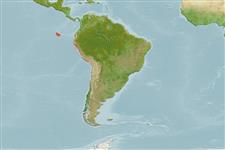>
Eupercaria/misc (Various families in series Eupercaria) >
Haemulidae (Grunts) > Haemulinae
Etymology: Anisotremus: Greek, anisos = unequal + Greek, trema, -atos = hole (Ref. 45335).
Environment: milieu / climate zone / depth range / distribution range
экология
морской ассоциированный с рифами; пределы глубины 3 - 30 m (Ref. 5227), usually 3 - 12 m (Ref. 5227). Tropical; 1°N - 24°S, 92°W - 70°W
Eastern Pacific: De Manta, Ecuador to Antofagasta, Chile.
Size / Вес / Возраст
Maturity: Lm ? range ? - ? cm
Max length : 58.0 cm TL самец/пол неопределен; (Ref. 122662); наибольший вес (опубликованные данные): 896.00 g (Ref. 53696)
Forms schools in open water above rocky, boulder strewn reefs and slopes and hard substrate with good water movement (Ref. 5227). Feeds on benthic invertebrates and floating organic matter (Ref. 28023).
Life cycle and mating behavior
половая зрелость | размножение | нерест | икра | Fecundity | личинки
Distinct pairing during breeding (Ref. 205).
Thomson, D.A., 1987. Reef fishes of the Sea of Cortez. The rocky-shore fishes of the Gulf of California. The University of Arizona Press, Tucson. 302 p. (Ref. 5592)
Статус Красного Списка МСОП (Ref. 130435)
Угроза для людей
Harmless
Использование человеком
дополнительная информация
ссылкиаквакультура (рыбоводство)особенности рыбоводствастепень растяжениягенетикаElectrophoresesнаследуемостьболезниобработкаNutrientsMass conversion
соавторыизображенияStamps, Coins Misc.звукиCiguateraскоростьтип плаванияжаберная областьOtolithsмозгзрение
инструменты
Специальные отчеты
Скачать в формате XML
ресурсы в Интернет
Estimates based on models
Preferred temperature (Ref.
123201): 19.2 - 23.9, mean 20.5 °C (based on 98 cells).
Phylogenetic diversity index (Ref.
82804): PD
50 = 0.5039 [Uniqueness, from 0.5 = low to 2.0 = high].
Bayesian length-weight: a=0.01230 (0.00808 - 0.01874), b=3.02 (2.89 - 3.15), in cm total length, based on LWR estimates for this species & (Sub)family-body (Ref.
93245).
Trophic level (Ref.
69278): 3.7 ±0.0 se; based on diet studies.
устойчивость к внешним воздействиям (Ref.
120179): средний (среднего размера), минимальное время удвоения популяции 1.4-4.4 года (Preliminary K or Fecundity.).
Fishing Vulnerability (Ref.
59153): Moderate vulnerability (43 of 100).
Nutrients (Ref.
124155): Calcium = 27.3 [12.8, 56.2] mg/100g; Iron = 0.49 [0.25, 0.89] mg/100g; Protein = 19 [17, 21] %; Omega3 = 0.0929 [, ] g/100g; Selenium = 33.1 [18.2, 60.4] μg/100g; VitaminA = 49 [15, 157] μg/100g; Zinc = 0.891 [0.581, 1.362] mg/100g (wet weight);
